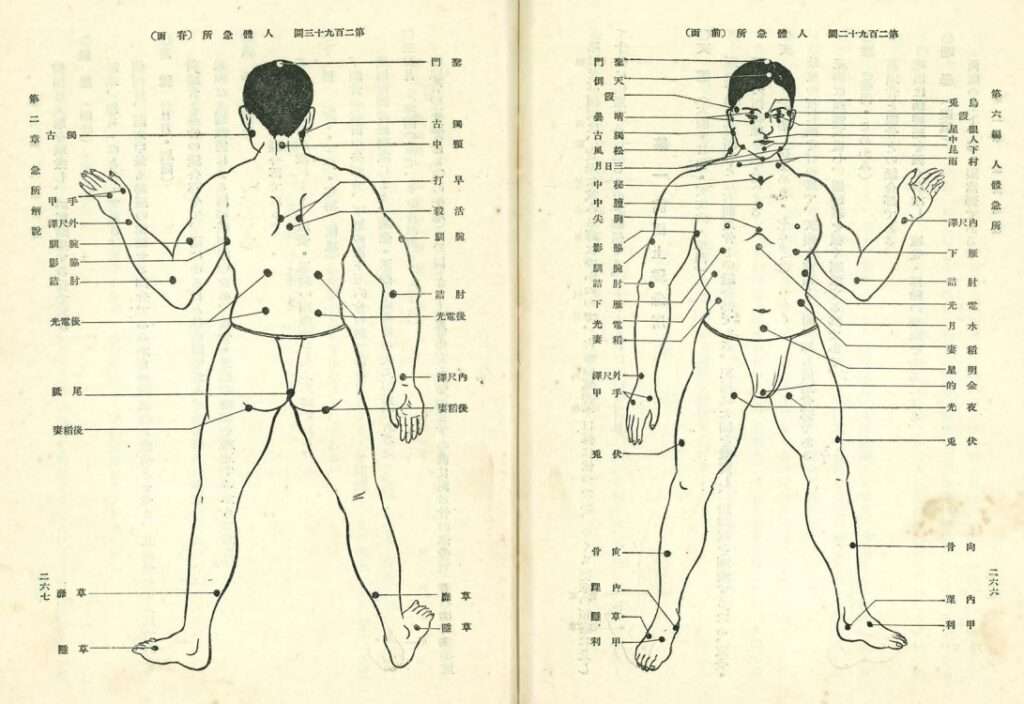What Are Pressure Points?
Many people associate pressure points with acupuncture and meridian lines, as acupuncture uses these points to promote healing and restore energy balance. In martial arts, pressure points are targeted to exploit vulnerable areas on the body for self-defense. While pressure points and vital points are related, they are not exactly the same. Vital points typically refer to areas that, if struck properly, can cause unconsciousness or even death, while pressure points are more focused on areas that can cause pain, discomfort, or temporary incapacitation. However, there is overlap between the two, with some pressure points also being vital points that can quickly disable an attacker.
Kyusho and Pressure Point Fighting
Kyusho, the study of vital points in martial arts, focuses on striking specific areas to disable an attacker. While pressure point strikes can be effective, they are challenging to apply in fast-paced situations.
Insights from the Bubishi
The Bubishi, an ancient Chinese martial arts text, provides valuable information on vital points. It describes areas on the body that can cause pain, unconsciousness, or even death if struck correctly. The Bubishi highlights the importance of timing, angle, and strike method to maximize effectiveness.
The text advises targeting soft tissue, nerve clusters, and weak structural points, rather than relying on brute force alone. Techniques often combine strikes with grappling or joint manipulation for better control.
Traditional Chinese Healing and Pressure Points
Chinese medicine identifies several vital points that overlap with martial arts techniques. While acupuncture stimulates these points to heal, martial arts uses them to disable or neutralize an opponent. Some common pressure points include:
Danzhong (CV 17)
- Location: Center of the chest, just above the midpoint between the nipples.
- Purpose: Known as the “Sea of Qi,” this point regulates energy flow, calms the mind, and supports breathing.
- Martial Arts Relevance: A strike to Danzhong can disrupt breathing and cause discomfort, but it is not as vulnerable as the solar plexus. It’s typically targeted with a palm or knuckle strike.
Solar Plexus
- Location: Below the sternum, where the ribcage meets.
- Martial Arts Relevance: A primary target in self-defense, as it controls diaphragm movement. A strong strike here can:
- Cause sudden loss of breath.
- Induce intense pain.
- Temporarily inhibit movement.
The solar plexus is far more vulnerable than Danzhong, making it a key target for disabling an attacker.

Key Vital Targets
Here are some of the most effective Vital points to target in self-defense:
- Eyes: Striking the eyes can cause intense pain, temporary blindness, and confusion. Aim for the eyeballs for maximum impact.
- Nose: A strong strike to the nose causes pain, tears, and disrupts balance, creating an opportunity for escape or counterattack.
- Jaw/Chin: Striking the jaw hinge or beneath the chin can snap the head back, causing pain and potentially stunning the attacker.
- Ears: Open-hand strikes or cupping motions around the ears can disrupt balance by affecting the inner ear.
- Back of the Neck: Striking or applying pressure to the back of the neck can disturb balance or lead to unconsciousness when combined with control techniques like a choke.
- Solar Plexus: Located below the sternum, a strike to this area can knock the wind out of an opponent, causing intense pain and breathing difficulty.
- Collarbone: Striking just below the collarbone can cause sharp pain and weaken the shoulder, limiting arm movement.
- Groin: While not typically seen as a traditional pressure point, striking the groin can immediately immobilize an attacker.
- Knee: Striking the knee can cause intense pain and disrupt an attacker’s ability to stand or move. A direct strike to the kneecap or a side kick to the knee joint can potentially dislocate or hyperextend the knee, making it difficult for the attacker to continue the assault. Targeting the knee is especially effective when the opponent is standing or advancing toward you, as it can severely limit their mobility.
Knockout Vital Points
To achieve a knockout, focus on areas that affect the brain’s balance or blood flow. The jaw hinge, temple, and back of the neck are common knockout targets. Precision, timing, and technique are key.
The Bubishi emphasizes that combining strikes with proper breathing control and body positioning increases the chances of achieving a knockout.
Practicality in Real Fight Considerations
In real self-defense situations, relying solely on precise pressure points can be risky. Fast-paced encounters make it challenging to strike small targets accurately. Instead, pressure points should complement natural, instinctive self-defense techniques, ensuring a more practical approach to self-defense under stress.
Focus on Larger, Accessible Targets
When facing an attacker, focusing on larger and more accessible vital points like the groin, throat, or solar plexus offers faster results. These areas are easier to target in high-pressure situations and can effectively disable an opponent when struck properly.
Enhance Basic Techniques with Pressure Points
Rather than depending solely on pressure points, you should enhance basic self-defense techniques. Incorporating pressure point knowledge into your natural, instinctive strikes-like punches, kicks, or elbows – can increase your effectiveness.
Pressure Points in Grappling
In grappling situations, you can press on pressure-sensitive areas like under the ear, or vital points such as the jaw hinge to weaken your opponent’s resistance. This can create an opportunity for further control, escape, or follow-up strikes.
The Role of Pressure Points in Real Fights
In high-stress, real-world situations, it’s essential to rely on techniques your body instinctively uses. Training with pressure points alongside these basic movements ensures that when an opening presents itself, you can act quickly and decisively. The goal is to use pressure points as part of a broader strategy, rather than depending on them as your sole method of defense.
Practical Tips
- Accuracy Over Power: Striking pressure points effectively often requires precision, not strength.
- Timing Matters: Strikes are more effective when delivered while the opponent is inhaling or during movement.
- Follow-Up Techniques: Combining pressure point strikes with follow-up attacks or controlling maneuvers improves their effectiveness.
Training to combine basic strikes with pressure point knowledge can enhance your ability to defend yourself in real-life situations.
Thanks for reading
Cheers, Gert
